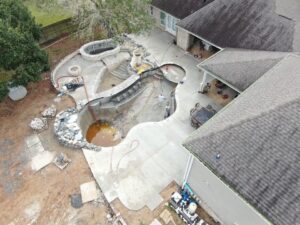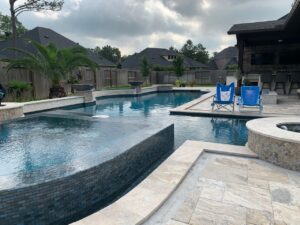So you find yourself searching for League City TX Pool Plastering Near Me and the search led you to our website. With temperatures rising to peak highs this summer, we don’t blame you for looking out and taking care of your pool.
After all, a pool is a great place to relax, enjoy some entertainment, and spend some time with family and friends. Pool plastering is a very important part of owning a pool, but we also offer services in other aspects of pool renovation:

We have the experience and knowledge to be your League City TX Pool Plastering Near Me company.
League City TX Pool Plastering Near Me
Our pool experts are highly trained and experienced in this field, with plenty of years of experience under their belts. On top of that, they are always learning more about their craft and improving. So, you can rest assured that our pool experts can do a great job for you.
In addition, we want to create safe and professional pool projects for you. After all, your needs change over time, and sometimes, the pool that you have now just isn’t working out for you. That is why you should rely on us to get you what you need to make your pool into a dream space!
We can also do things like expanding your pool, remodeling your pool, making additions to your swimming pool, and more. You can call one of our pool experts to get your free estimate today!
Pool plastering is one of the more common types of projects we work on here at JR Pool Plastering & Texas Gunite Ltd. We perform our plastering services on pools that are cracked, discolored, or just really old. If you feel like something is wrong with your pool, check for leaks.
There are different options for plaster, and some are more durable than others. Here are some signs that your pool probably needs replastering.
Stains
Pool plaster does stain one way or another because the natural material that makes up pool plaster will take up colored substances. Sometimes you’ll find mineral stains that can be the result of poor water chemistry, which needs to be addressed.
If you don’t keep your pool’s water chemistry balanced, you could find yourself dealing with new stains on your replastered pool much faster than you would like.
One way of combating stains is acid washing, but only to an extent because too much acid washing can lead to roughness on the surface of the pool. For proactive pool owners, ask your pool contractor about available performance-enhancing products for the pool’s plaster. Some products on the market can help fight stains, retain color, and extend the life of the plaster.
Roughness
The surface of the pool will eventually become rough; this is the result of a number of things, including:
- Age
- Excessive acid washing
- Poorly done plaster job
Roughness on the pool’s surface is a risk to swimsuits and can cause scraped skin and algae that can be a big problem to remove. If only part of your pool is showing signs of roughness, you may be able to fix the problem by sanding down the plaster.
If the roughness occurs throughout the pool, the plaster will have to be replaced completely,
Thinning, Chipping, and Leaks
When you see dark spots in the pool that don’t look like regular stains, they may be areas of the pool plaster that are too thin. A plaster that’s this thin is going to allow underlying concrete through.
When chips of plaster fall off or cracks form, the entire plaster can come off. You can find some materials that fix small cracks and chips. When excessive thinning and chipping happen to a pool, it can lead to leaks.
Loss of Color
Pools that are a color besides white can lose their color over time. The reason for the loss of color can be associated with water chemistry imbalance or problems with the material used to create the color.

You can count on JR Pool Plastering & Texas Gunite Ltd. to get your pool in great condition.
Plaster companies can use organic color pigments in their plaster if they want to save on production. The problem with organic color pigments is that they fade quickly. There are also pool plastering companies that instead use inorganic color pigments in their plaster, ensuring a longer life for the pool’s surface.
How It’s Done
Replastering a pool can take anywhere from a few days to a few weeks. It all depends really on the size and total design of the pool. The first thing that needs to be done is to remove the plaster and begin pouring the new one.
After the plaster is done being poured, it has to be given time to cure and harden. The next step is to even everything out and apply the finishing touches. This allows the plaster to shine as much as possible.
After all of that, the pool will need to be refilled.
There are various reasons for replastering a pool, but doing it at the right time is also important. You’ll normally want to replaster your pool during a time of year when the temperature ranges somewhere between 50 to 75 degrees Fahrenheit and a good level of humidity. While that is the recommended temperature range, our crews can definitely complete projects outside of that range.
It’s highly recommended that pool owners avoid replastering their pool in temperatures colder than 50 degrees Fahrenheit. When the weather gets too hot or too dry, the new plaster can begin to dry too fast and start to develop tiny cracks.
Another element to keep in mind is wind because it can kick up dirt and debris. In some areas, some winds can get a bit too extreme for our workers to come out. If you reach out to us, we can make a recommendation based on your specific circumstances.
The Costs of Replastering

Ask us about our re-plastering services.
Pool replastering costs can be affected by many factors, including:
- Size of pool
- Shape of pool
- Colors or finishes
The two most important variables in the cost of replastering are the size and shape of the pool. Some pools are uniquely designed and shaped in complex ways; these types of pools are going to require more work and cost more.
We have the experience and knowledge to help clients and become their League City TX Pool Plastering Near Me.
League City, TX Fun Facts
- This waterfront community is located along the shores of Clear Lake.
- League City is close to Galveston Bay and the Gulf of Mexico.
- It’s 30 miles from downtown Houston.